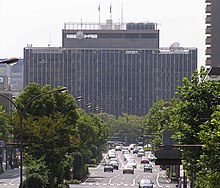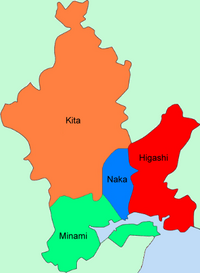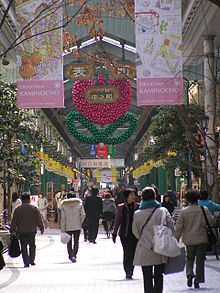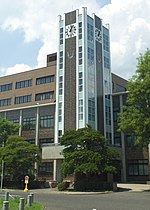Okayama
This article has multiple issues. Please help improve it or discuss these issues on the talk page. (Learn how and when to remove these messages)
|
Okayama
岡山市 | |
|---|---|
| Okayama City | |
 (From top, left to right : Okayama Castle • Okayama Kōraku-en Garden • Kibitsu Jinja • Kibidango • Omote-chō shopping arcade • Nishigawa Green Park) | |
 Location of Okayama in Okayama Prefecture | |
 | |
| Coordinates: 34°39′N 133°55′E / 34.650°N 133.917°E | |
| Country | Japan |
| Region | Chūgoku (San'yō) |
| Prefecture | Okayama |
| Government | |
| • Mayor | Masao Omori |
| Area | |
• Total | 789.95 km2 (305.00 sq mi) |
| Population (February 1, 2023) | |
• Total | 700,940 |
| • Density | 890/km2 (2,300/sq mi) |
| Time zone | UTC+09:00 (JST) |
| City hall address | 1-1-1 Daitomo, Kita-ku, Okayama-shi, Okayama-ken 700-8544 |
| Website | Official website |
| Symbols | |
| Bird | Red-crowned crane |
| Flower | Chrysanthemum |
| Tree | Ilex rotunda; Lagerstroemia indica |


Okayama (岡山市, Okayama-shi, Japanese: [okaꜜjama]) is the capital city of Okayama Prefecture in the Chūgoku region of Japan. The Okayama metropolitan area, centered around the city, has the largest urban employment zone in the Chugoku region of western Japan. The city was founded on June 1, 1889.[1] As of February 2023[update], the city has an estimated population of 700,940 and a population density of 890 people per km2.[2] The total area is 789.95 square kilometres (305.00 square miles).
The city is the site of Kōraku-en, known as one of the top three traditional gardens in Japan, and Okayama Castle, which is ranked among the best 100 Japanese castles.[3] The city is famous as the setting of the Japanese fable Momotarō.[4] Okayama joined the UNESCO Global Network of Learning Cities in 2016.
History
Sengoku period to Bakumatsu period

Before the Muromachi period, Okayama was one corner of a farm region and included a small castle built by the Kanemitsu. In the Sengoku period, Ukita Naoie attacked Okayama and attacked the castle for the transportation resources and extensive farmland in the region. Naoie remodeled the castle, built the old Sanyo road to the central part of the castle town, and called in craftsmen both from inside and outside of Bizen Province. Okayama became the political and economical capital of Bizen Province.
In 1600, Ukita Hideie, who was the son of Naoie and the lord of Okayama, lost at the Battle of Sekigahara. The next year, Kobayakawa Hideaki came to Okayama and became the feudal lord of Okayama Domain. Hideaki died in 1602, however, ending the Kobayakawa line. Ikeda Tadatugu, who was the feudal lord of Himeji Domain, became the next lord of Okayama. After this time, Okayama was ruled by the Ikedas until the latter part of the 19th century. Continuing its economic development, Okayama became one of the ten best large castle towns in Japan in the 18th century. The Korakuen Garden was developed by the fourth feudal lord, Ikeda Tsunamasa.
Meiji Restoration to World War II

On August 29, 1871, the new Meiji government of the Empire of Japan replaced the traditional feudal domain system with centralized government authority. Okayama became the capital of Okayama Prefecture. In 1889, Okayama City was founded with the establishment of the modern municipalities system. In the Meiji period, a San'yo Main Line railroad and other local lines greatly enhanced the development of the city. The Sixth Higher Middle School (第六高等学校, Dairoku Kōtōgakkō) and Okayama Medical College (岡山医科大学, Okayama Ika-daigaku) were established in Okayama City. Okayama became a center in western Japan for transportation and education. When World War II began, Okayama city was a garrison city for the Imperial Japanese Army. On June 29, 1945, the city was attacked by the US Army Air Forces with incendiary bombs. Almost all the city was burned, and more than 1700 people were killed. Okayama suffered terrible damage in the war, losing more than 12,000 households.
Since World War II
During Japan's economic boom of the 1960s, Okayama developed rapidly as one of the most important cities in the Chūgoku and Shikoku regions. In 1972, the San'yō Shinkansen began service between Shin-Ōsaka and Okayama stations. Two years later, Shinkansen service was extended to Hakata. In 1988, the Seto-Ōhashi Bridge was opened, and connected Okayama with Shikoku directly by rail and road.
The city became a core city in 1996 and a designated city on April 1, 2009 with increased local autonomy.[5]
On March 22, 2005 the town of Mitsu (from Mitsu District), and the town of Nadasaki (from Kojima District) were merged into Okayama. This was followed on January 22, 2007 when the town of Takebe (from Mitsu District), and the town of Seto (from Akaiwa District) were merged into Okayama. Kojima, Mitsu, and Akaiwa Districts have all since been dissolved as a result of these mergers.
Geography
The city of Okayama is located in the southern part of Okayama Prefecture, which is located in western part of the island of Honshū. The northern part of the city forms a corner of Kibi Plateau, which is a series of gentle hills, and includes the Asahikawa Dam, Okayama Airport, and a suburban residential area. The central urban area is located on the Okayama Plain in the south, which was formed by the transportation and sedimentation of two first-class rivers, the Asahi River and Yoshii River, which flow into the Seto Inland Sea. To the south of the main urban area is Kojima Bay, which forms the scenic Kojima Peninsula overlooking the Seto Inland Sea.
Neighboring municipalities
Okayama Prefecture
Climate
Okayama has a mild climate in comparison to most of Japan. It has the most rain-free days (less than 1mm of precipitation) of any city in Japan. It is ranked as the second driest and the fourth sunniest city in the Chūgoku region.[6] The climate is classified under the Köppen climate classification as humid subtropical (Cfa).[7]
The local climate is warm enough throughout the year to support olive trees. Okayama is often called "Land of Sunshine" because of its low number of rainy days per year.[8]
| Climate data for Okayama (1991−2020 normals, extremes 1891−present) | |||||||||||||
|---|---|---|---|---|---|---|---|---|---|---|---|---|---|
| Month | Jan | Feb | Mar | Apr | May | Jun | Jul | Aug | Sep | Oct | Nov | Dec | Year |
| Record high °C (°F) | 18.8 (65.8) |
22.3 (72.1) |
24.8 (76.6) |
29.6 (85.3) |
33.6 (92.5) |
37.0 (98.6) |
38.1 (100.6) |
39.3 (102.7) |
37.1 (98.8) |
33.4 (92.1) |
26.9 (80.4) |
21.5 (70.7) |
39.3 (102.7) |
| Mean daily maximum °C (°F) | 9.6 (49.3) |
10.5 (50.9) |
14.6 (58.3) |
19.8 (67.6) |
24.8 (76.6) |
27.6 (81.7) |
31.8 (89.2) |
33.3 (91.9) |
29.1 (84.4) |
23.4 (74.1) |
17.1 (62.8) |
11.7 (53.1) |
21.1 (70.0) |
| Daily mean °C (°F) | 4.6 (40.3) |
5.2 (41.4) |
8.7 (47.7) |
14.1 (57.4) |
19.1 (66.4) |
22.7 (72.9) |
27.0 (80.6) |
28.1 (82.6) |
23.9 (75.0) |
18.0 (64.4) |
11.6 (52.9) |
6.6 (43.9) |
15.8 (60.4) |
| Mean daily minimum °C (°F) | 0.1 (32.2) |
0.5 (32.9) |
3.5 (38.3) |
8.5 (47.3) |
14.8 (58.6) |
18.7 (65.7) |
23.4 (74.1) |
24.6 (76.3) |
20.0 (68.0) |
13.4 (56.1) |
6.8 (44.2) |
2.1 (35.8) |
11.4 (52.5) |
| Record low °C (°F) | −8.9 (16.0) |
−9.1 (15.6) |
−7.0 (19.4) |
−3.6 (25.5) |
1.0 (33.8) |
7.4 (45.3) |
12.6 (54.7) |
14.8 (58.6) |
7.2 (45.0) |
1.7 (35.1) |
−3.5 (25.7) |
−6.5 (20.3) |
−9.1 (15.6) |
| Average precipitation mm (inches) | 36.2 (1.43) |
45.4 (1.79) |
82.5 (3.25) |
90.0 (3.54) |
112.6 (4.43) |
169.3 (6.67) |
177.4 (6.98) |
97.2 (3.83) |
142.2 (5.60) |
95.4 (3.76) |
53.3 (2.10) |
41.5 (1.63) |
1,143.1 (45.00) |
| Average snowfall cm (inches) | 0 (0) |
1 (0.4) |
0 (0) |
0 (0) |
0 (0) |
0 (0) |
0 (0) |
0 (0) |
0 (0) |
0 (0) |
0 (0) |
0 (0) |
1 (0.4) |
| Average precipitation days (≥ 0.5 mm) | 5.4 | 6.9 | 9.2 | 9.6 | 9.4 | 11.6 | 10.9 | 7.7 | 9.7 | 7.7 | 6.4 | 6.3 | 100.8 |
| Average relative humidity (%) | 69 | 66 | 65 | 60 | 64 | 71 | 74 | 69 | 71 | 71 | 72 | 71 | 69 |
| Mean monthly sunshine hours | 149.0 | 145.4 | 177.8 | 192.6 | 205.9 | 153.5 | 169.8 | 203.2 | 157.5 | 171.5 | 153.7 | 153.8 | 2,033.7 |
| Source: Japan Meteorological Agency[9] | |||||||||||||
Demographics
Per Japanese census data,[10] the population of Okayama is as follows:
| Year | Pop. | ±% p.a. |
|---|---|---|
| 1960 | 432,177 | — |
| 1970 | 500,599 | +1.48% |
| 1980 | 590,424 | +1.66% |
| 1990 | 640,406 | +0.82% |
| 2000 | 674,375 | +0.52% |
| 2010 | 709,622 | +0.51% |
Government
Okayama has a mayor-council form of government with a directly elected mayor and a unicameral city legislature of 46 members. The city contributes 19 members to the Okayama Prefectural Assembly. In terms of national politics, the city is divided between of the Okayama 1st District, Okayama 2nd District and Okayama 3rd District of the lower house of the Diet of Japan.
Local administration
Since Okayama became a designated city in 2009, the city has been divided into four wards (ku).
| Ward | Population | Area (km2) | Density (per km2) |
Map |
|---|---|---|---|---|
| Kita-ku
(northern ward) |
302,685 | 451.03 | 671 | 
|
| Naka-ku
(central ward) |
142,237 | 51.24 | 2,776 | |
| Higashi-ku
(eastern ward) |
96,948 | 160.28 | 605 | |
| Minami-ku
(southern ward) |
167,714 | 127.36 | 1,317 | |
| Population as of October 1, 2010 | ||||
Economy


Agriculture
The city is located in the Okayama Plain, where rice, eggplant, and white Chinese chives are notable products.[11] White peaches and grapes are cultivated in the mountainous, northern part of the city.
Industry
In 2005, the city's gross domestic product was 800 billion yen,[12] nearly 10% of the GDP of Okayama Prefecture. Greater Okayama, Okayama Metropolitan Employment Area, has a GDP of US$63.1 billion as of 2010.[13][14] The main industries are machine tools, chemicals, foodstuffs and printing. Kōnan, a district in the southern part of the city, is the most developed industrial zone.
Commerce
Okayama is the core of the Okayama metropolitan area, which includes the cities of Kurashiki and Sōja. The main commercial district is Omotechō, near Okayama Castle and Kōraku-en, and the area surrounding Okayama Station. Omotechō has many covered shopping arcades.
The headquarters of Aeon Corporation, a private English language school with more than 3,000 employees, is located in Okayama.[15]
Education

Okayama University, founded as a medical school in 1870 and established in 1949 as a national university,[16] is in the city. Today, Okayama University is Okayama's largest university, with 8 faculties and seven graduate schools.[17]
There are seven private universities, three junior colleges, 24 high schools (16 public, eight private), seven combined junior high/high schools (two public, five private), 38 junior high schools (37 municipal, one national) and 93 elementary schools (91 municipal, two private) in the city.[citation needed]
Universities
- Chugoku Gakuen University (private)
- International Pacific University (private)
- Notre Dame Seishin University (private)
- Okayama Healthcare Professional University (private)
- Okayama Shoka University (private)
- Okayama University (national)
- Okayama University of Science (private)
- Sanyo Gakuen University (private)
- Shujitsu University (private)
High schools
- Okayama Asahi Senior High School
- Okayama Gakugeikan High School
- Okayama Hosen Senior High School
- Okayama Ichinomiya Senior High School
- Okayama Joto Senior High School
- Okayama Sozan Senior High School
Transportation

Airports
- Okayama Airport, located in the northern part of the city, provides both domestic and limited international services
- Kōnan Airport, located to the south, has been a general aviation airport since the opening of Okayama Airport in 1988.
Railway
JR West's Okayama Station is a major interchange, with trains from Shikoku, Sanin and San'yo connecting to the San'yō Shinkansen. Local rail lines serving Okayama Station include:
- Mantomi – Seto – Joto – Higashi-Okayama – Takashima – Nishigawara – Okayama – Kitanagase – Niwase
- Okayama – Omoto – Bizen-Nishiichi – Senoo – Bitchū-Mishima – (Hayashima Town - Kurashiki City) – Hikosaki – Bizen-Kataoka – Hazakawa
- Okayama – Hōkaiin – Bizen-Hara – Tamagashi – Makiyama – Nonokuchi – Kanagawa – Takebe – Fukuwatari
- Okayama – Bizen-Mikado – Daianji – Bizen-Ichinomiya – Kibitsu – Bitchū-Takamatsu – Ashimori
Tramway
Okayama has kept an operational tram system since the Meiji period. It is managed by Okayama Electric Tramway and offers two lines: the Higashiyama Main Line and the Seikibashi Line.
Bus
Seven bus companies provide service within the city limits: Bihoku Bus (備北バス), Chūtetsu Bus (中鉄バス), Okaden Bus (岡電バス), Ryōbi Bus (両備バス), Shimoden Bus (下電バス), Tōbi Bus (東備バス), and Uno Bus (宇野バス).
Sister cities
 San Jose, California, United States (established on May 26, 1957)[19]
San Jose, California, United States (established on May 26, 1957)[19] San José, Costa Rica (established on January 27, 1969)[20]
San José, Costa Rica (established on January 27, 1969)[20] Plovdiv, Bulgaria (established on April 28, 1972)[20]
Plovdiv, Bulgaria (established on April 28, 1972)[20] San Antonio, Texas, United States (established on April 12, 1976)
San Antonio, Texas, United States (established on April 12, 1976) Luoyang, China (established on April 6, 1981)[20]
Luoyang, China (established on April 6, 1981)[20] Bucheon, Gyeonggi-do, South Korea (friendship city since 2002)
Bucheon, Gyeonggi-do, South Korea (friendship city since 2002) Hsinchu, Taiwan (friendship city since 2003)
Hsinchu, Taiwan (friendship city since 2003)
Media

The Sanyo Shimbun is the local newspaper serving the greater Okayama area. There are six television stations serving the Okayama area and part of Kagawa Prefecture. Three FM and three AM radio stations also serve the region.
- TV stations
| Channel ID | Name | Network | Established year | Call sign |
|---|---|---|---|---|
| 1 | NHK General TV Okayama | NHK General TV | 1957 | JOKK-DTV |
| 2 | NHK Educational TV Okayama | NHK Educational TV | 1963 | JOKB-DTV |
| 4 | Nishinippon Broadcasting Co., Ltd.(RNC) | NNN | 1958 | JOKF-DTV |
| 5 | Setonaikai Broadcasting Co., Ltd.(KSB) | ANN | 1969 | JOVH-DTV |
| 6 | Sanyo Broadcasting Co., Ltd.(RSK) | JNN | 1958 | JOYR-DTV |
| 7 | TV Setouchi Broadcasting Co., Ltd.(TSC) | TXN | 1985 | JOPH-DTV |
| 8 | Okayama Broadcasting Co., Ltd.(OHK) | FNN | 1969 | JOOH-DTV |
- Radio stations
| Channel | Name | Network | Established year | Call sign |
|---|---|---|---|---|
| AM 603 kHz | NHK Radio Daiichi Okayama | NHK Radio Daiichi | 1931 | JOKK |
| AM 1386 kHz | NHK Radio Daini Okayama | NHK Radio Daini | 1946 | JOKB |
| AM 1494 kHz | Sanyo Broadcasting Co, Ltd.Radio (RSK) | JRN, NRN | 1958 | JOYR |
| FM 88.7 MHz | NHK FM Okayama | NHK FM | 1964 | JOKK-FM |
| FM 76.8 MHz | FM Okayama | JFN | 1999 | JOVV-FM |
| FM 79.0 MHz | Radio MOMO (Okayama City FM) | J-WAVE | 1997 | JOZZ8AD-FM |
Sports
Okayama has many sports teams. In recent years, volleyball team Okayama Seagulls and football club Fagiano Okayama have been established. In 2009, Fagiano Okayama gained promotion to the J.League, the highest football league in Japan.
| Club | Sport | League | Venue | Established |
|---|---|---|---|---|
| Fagiano Okayama | Football | J1 League | City Light Stadium (Okayama Prefectural Multipurpose Athletic Stadium) | 2004 |
| Okayama Seagulls | Volleyball | V.League | Momotaro Arena (Okayama Prefectural Multipurpose Grounds Gym) | 1999 |
| Okayama Standing Bears | American football | X-League | Kanko Stadium (Okayama Prefectural Multipurpose Athletic Stadium) | ? |
| Citylight Okayama Baseball Team | Baseball | Semi-professional baseball | 2008 |
Local attractions

- Handayama Botanical Garden
- Hayashibara Museum of Art
- Kibitsuhiko Shrine
- Kibitsu Shrine
- Kōraku-en, known as one of the three best traditional gardens in Japan, lies south of the castle grounds. Kōrakuen was constructed by Ikeda Tsunamasa over 14 years, and completed in 1700.
- Okayama Castle, constructed in 1597. It was destroyed by bombing in 1945 during World War II but reconstructed in 1966.
- Okayama Prefectural Museum
- Okayama Prefectural Museum of Art
- Okayama Orient Museum
- Okayama Symphony Hall
- Yumeji Art Museum
National Historic Sites
- Bitchū-Takamatsu Castle
- Hata temple ruins Pagoda Site
- Hikozaki Shell Mound
- Jingūjiyama Kofun
- Magane Ichirizuka
- Mantomi Tōdai-ji Tile Kiln Site
- Musa Ōtsuka Kofun
- Ōdara Yosemiya ruins
- Okayama Castle
- Okayama Domain Ikeda clan cemetery
- Former Okayama Domain Han School
- Ōmeguri-Komeguri Mountain Castle ruins
- Onoe Kurumayama Kofun
- Shōda temple ruins
- Sōzume Tō
- Tsukuriyama Kofun
- Tsushima Site
- Urama Chausuyama Kofun
Festivals
Every August since 1994 Okayama has seen the Momotarō Matsuri (Festival), which is an amalgam of three different festivals, including the Uraja 'ogre' festival, which is a kind of Yosakoi dance.
Music

- Okayama Symphony Orchestra, performs at the Okayama Symphony Hall.
- Inryō-ji, a Buddhist temple near the city centre, regularly hosts concerts.
Cuisine
Okayama has several traditional dishes.Barazushi, a dish made with sushi rice, contains fresh fish from the Seto Inland Sea. Kibi dango (Okayama) (吉備団子) gel-like balls made from a powder of millet and rice, are well known sweets from the area.
Notable people
Premodern
- Eisai (Buddhist priest, 1141–1215)
- Kōan Ogata (Rangaku practitioner, 1810–1863)
- Hideie Ukita (Military commander, 1573–1655)
Arts
- Takashi Fukutani (manga artist, 1952–2000)
- Masashi Kishimoto (manga artist, 1974– )
- Seishi Kishimoto (manga artist, 1974– )
- Shigeru Nanba (painter, 1944– )
Politics
- Ichirō Aisawa (Member of the House of Representatives, 1954– )
- Kenji Eda (Member of the House of Representatives, Secretary General of Your Party, 1956– )
- Satsuki Eda (Member of the House of Councillors, 27th President of the House of Councillors, 1941– )
- Seiji Hagiwara (31st, 32nd Mayor of Okayama, member of the House of Representatives, fourth Mayor of Mimasaka, Okayama, 1956– )
- Tsuyoshi Inukai (Member of the House of Representatives, 29th Prime Minister of Japan, 1855–1932)
- Masahiro Ishii (5th Governor of Okayama Prefecture, Member of the House of Councillors, 1945– )
- Yoshihiro Katayama (Governor of Tottori Prefecture, Minister of Internal Affairs and Communications, 1951– )
- Akihiko Kumashiro (Member of the House of Representatives, 1940– )
- Shigeo Takaya (33rd, 34th Mayor of Okayama, 1937– )
- Keisuke Tsumura (Member of the House of Representatives, 1971– )
- Michiyoshi Yunoki (Member of the House of Representatives, 1972– )
Literature
- Suiin Emi (novelist, 1869–1934)
- Yōko Ogawa (novelist, 1962– )
- Hyakken Uchida (novelist, 1889–1971)
- Junnosuke Yoshiyuki (novelist, 1924–1994)
Entertainment
- Angela Aki (singer-songwriter, 1977– ) (attended middle school in Okayama)
- Dorlis (musician, 1982– )
- Fujii Kaze (singer-songwriter, born June 14, 1997)
- Hiroto Kōmoto (musician, 1963– )
- MISA (bassist for Band-Maid - October 15)
- Shinji Morisue (former artistic gymnast and TV personality, 1957– )
- Riki Nishimura (member of the K-pop boy group Enhypen, born 2005 )
- Miku Nishizaki (member of Ocha Norma, born 2006)
- Matsunosuke Onoe (actor and film director, 1875–1926)
- Etsuko Shihomi (actress, 1955– )
- Yukiko Takaguchi (voice actor, 1974– )
- Tomu Uchida (film director, 1898–1970)
Sports

- Noboru Akiyama (baseball player and coach, 1934–2000)
- Yuko Arimori (athlete, 1966– )
- Naoko Hashimoto (volleyball player, 1984– )
- Shigeaki Hattori (racing driver and team owner, 1963– )
- Kinue Hitomi (athlete, 1907–1931)
- Tsunenohana Kan'ichi (sumo Yokozuna, b. 1896)
- Masahiro Kawai (baseball player, 1964– )
- Issei Morita (baseball player, 1989– )
- Maurice Ndour (born 1992) (Senegalese basketball player for Hapoel Jerusalem of the Israeli Basketball Premier League)
- Hikaru Sato (wrestler and mixed martial artist, 1980– )
- Hinako Shibuno (golfer, 1998– )
- Kiyoshi Tamura (wrestler, 1969– )
- Hisashi Tsuchida (soccer player, 1967– )
Inventors
- Seiichi Miyake (inventor of tactile paving, 1926–1982)
References
- ^ "Overview of Okayama City/Okayama city (Okayama-shi) is the capital of Okayama Prefecture". City.okayama.jp. Retrieved 21 February 2015.
- ^ "Official website of Okayama city" (in Japanese). Japan: Okayama City. Retrieved 11 April 2017.
- ^ "Castles / List of Japanese Castles". Japan-Guide.com. Retrieved 21 February 2015.
- ^ ""Momotaro", a folk tale and Kibiji District". City.okayama.jp. Archived from the original on 21 February 2015. Retrieved 21 February 2015.
- ^ [1] Archived August 7, 2009, at the Wayback Machine
- ^ "Outline of Okayama". Pref.okayama.jp. Archived from the original on 2013-01-02. Retrieved 2013-10-04.
- ^ "World Maps of Köppen-Geiger climate classification". Koeppen-geiger.vu-wien.ac.at. Retrieved 2013-10-04.
- ^ 大好き「晴れの国おかやま」 1 岡山県のアウトライン(県の概況、シンボルなど) - 岡山県ホームページ. Pref.okayama.jp. Archived from the original on 2011-07-20. Retrieved 2013-10-04.
- ^ 気象庁 / 平年値(年・月ごとの値). Japan Meteorological Agency. Retrieved May 19, 2021.
- ^ Okayama population statistics
- ^ [2] Archived August 28, 2010, at the Wayback Machine
- ^ "??" (PDF) (in Japanese). City.okayama.jp. Retrieved 21 February 2015.
- ^ Yoshitsugu Kanemoto. "Metropolitan Employment Area (MEA) Data". Center for Spatial Information Science, The University of Tokyo.
- ^ Conversion rates - Exchange rates - OECD Data
- ^ [3] Archived February 20, 2009, at the Wayback Machine
- ^ "History - Okayama University".
- ^ "Organization Chart - Okayama University".
- ^ "The History of Okayama". city.okayama.jp. Okayama. Retrieved 2020-04-07.
- ^ "Northern and Central California Sister Cities in Japan". Archived from the original on October 26, 2019. Retrieved June 15, 2019.
- ^ a b c "姉妹(友好)提携情報". 自治体国際化協会. Archived from the original on October 27, 2012. Retrieved June 1, 2016.
External links
- Okayama City official website (in Japanese)
- Okayama City official website
- I Love Okayama - Okayama global brand
 Geographic data related to Okayama at OpenStreetMap
Geographic data related to Okayama at OpenStreetMap



